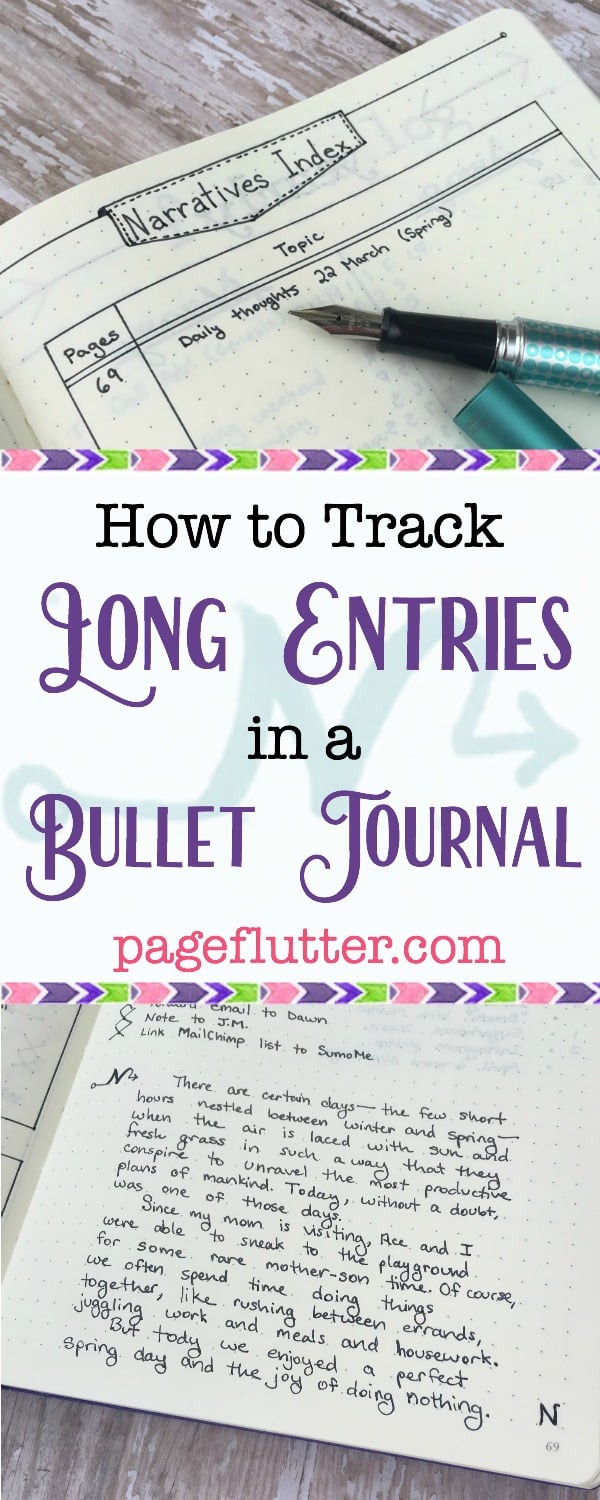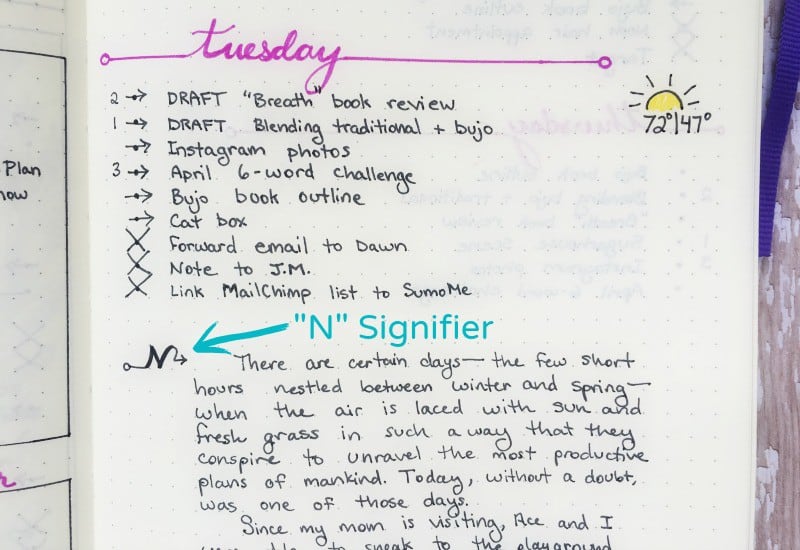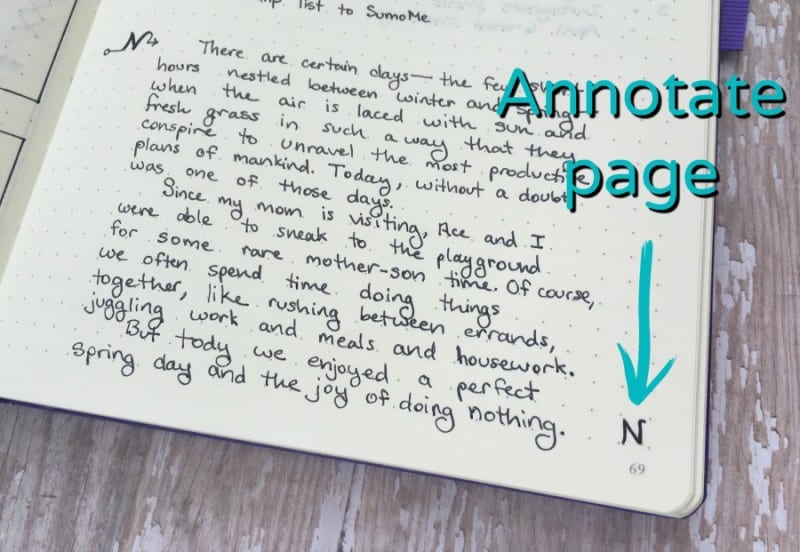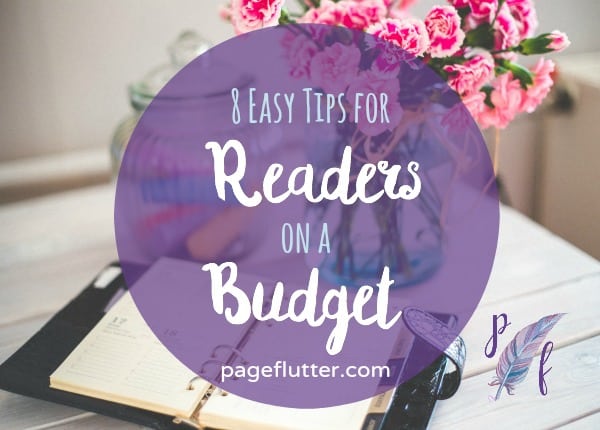Long entries (a.k.a narrative entries), written in narrative or paragraph format instead of bullets, can be personal reflections, or (*muses willing*) strokes of inspiration that demand immediate attention.

How to Track Long Entries in a Bullet Journal | The Narrative Entry Hack
Today, I have a quick post addressing the topic of long narrative entries, a topic I’ve seen popping up in a few Facebook threads recently.
Rapid Logging vs. The Almighty Paragraph
Before I started my bullet journal, I wrote out my journal entries in traditional paragraph format. It worked well to capture the twisted workings of my weird little mind, but it didn’t do much for my productivity or organizational needs.
I was thrilled that my bullet journal could consolidate 2 half-filled day planners, 1 iCal, 3 stacks of Post-its, 5 spiral Steno pads, and so many excel sheets I can’t even count. I could keep my writing lists, ideas, schedule, family events, goals–in short, everything. In. One. Handy. Notebook.
But somewhere along the way, I realized I needed a place to record long entries. Long entries, written in narrative or paragraph format instead of bullets, can be personal reflections, or (*muses willing*) strokes of inspiration that demand immediate attention. Either way, I couldn’t completely abandon traditional journaling.
Here are a few techniques I’ve flirted with, but each one has specific downsides:
- Placing long/narrative entries at back of the journal. You work from both ends of the journal at once, eventually meeting in the middle. It’s not a bad approach, but it can make indexing a bit more challenging, and you’ll have to flip around in your journal if you need the long entries for a project on your task list.
- Split spreads—one side for long entries, the other for bullets. Again, this puts space in your journal that might be wasted.
- A separate journal. There are times when a separate notebook makes sense, but you should aim for a solitary bullet journal, if at all possible. The more you have to carry around, the less likely you are to keep up with it all.
The core strength of the bullet journal system is its adaptability, so I knew there had to be a simple solution. Without further delay, I present…
The “Narrative Entry” hack!

You’re probably already familiar with the building blocks of the bullet journal system, but if not, take a minute to check out this post. My Narrative Entry approach is based on the daily entries.
When you get to your dailies, input your bullets just as you normally would.
Let’s use last Tuesday as an example:

I migrate tasks to my Tuesday entry on Monday night (TIP: Don’t try to get ahead with your dailies; it will muck up the whole system). Some days you won’t have anything long to write, some days you will.
When Tuesday rolls around and genius strikes (as it so often does), I draw my “N” signifier with an arrow to indicate I’m starting a narrative entry.

I annotate the page with an “N”, my signifier for narrative entries. Annotating the page with the signifier is something I picked up from Kim at Tiny Ray of Sunshine. She wrote a fantastic post about her “Signifier Magnifier” to locate the type of information located on a given page. I list the signifiers (in this case, my special “N”) above the page number so I can tell what type of information is on each page simply by fanning through my notebook.

Next I record the page number in my Narrative Index. This is a special spread I recently created to supplement my bullet journal index. I can keep track of where my narrative entries are in my journal at a glance without cluttering my main index.

Why a separate index? Sometimes narrative entries are nothing more than musings and reflections, but often they play a part in the projects on my task list. I might need an entry visible throughout the day to focus my thoughts. By indexing long entries separately, I can also give them all a quick skim for inspiration. Now, my topics are neatly gathered in a central spread without separating the actual entries from the tasks that inspired them.
Most importantly, this hack adheres to the bullet journal framework. I can always work forward in my journal, and I don’t have to fill in pages ahead of time.
Now, the abstract chaos of my mind is free to wander around on the page, and the logical/sequential bullet journal system can whip it back into an actionable plan. Problem solved!
If you enjoyed this tip, you won’t want to miss my newsletters. Sign up here to get the inside track on what I’m up to at Page Flutter!
Your turn! Do you use long/narrative entries in your bullet journal? I’d love to know what type of information you keep in your journal!
Brainstorm with me!
Subscribe to my newsletter for Page Flutter updates, posts, and announcements,
and FREE access to resources in the Vault!
Don’t worry, I only deliver the good stuff. No spam.
Facebook // Twitter// Instagram // Pinterest
SaveSave










I traditionally journal as well. I started bullet journaling almost a month ago. After a couple weeks of dailies I grew to not like it. Now I use weeklies and let my long entries follow though. I like your idea of a separate index and the signifier. I may adapt them into my own. Thank you so much!
I’m glad you found a system that works for you, Fida! Journaling is so personal, no two people can journal the exact same way. Thank you for reading and commenting. Hope to hear from you again soon!
I set aside rime each night to add a “narrative”, after I’ve set up the next day. I intentionally shorten the room I have, because I tend to be long-winded in writing and have a bad wrist. I don’t put them in the index, though, since I try to make a point of doing it every day… But I do make sure to leave an obvious distinction between the two sections. Thanks for the tip though – I may incorporate a signifier at some point!
Babz, I love your take on long entries. If it’s part of your dailies, then I agree, a separate index might not be necessary. Mine tend to make the index if they deal with a specific topic, or if I want to use them later for a larger creative writing project. Thanks again for your insight! xo 😉
And if I ever end up using them for something other than tracking my mental health highs and lows for the day, I will most likely put them in my index. For now, though, they’re all pretty much the same topic. Lol!
Great tip! I’ve been having trouble fitting longer notes into the daily pages.
I’ve also been trying to do do one page per day, but I really like your color header for each day, so you can run continuously and not waste as much space as I’ve been doing on some days. The beauty of the Bullet Journal — you can change any time you like to make it work better for you. 🙂
I couldn’t agree more! I am constantly changing and adapting when life throws me a curve ball. Happy journaling! 🙂